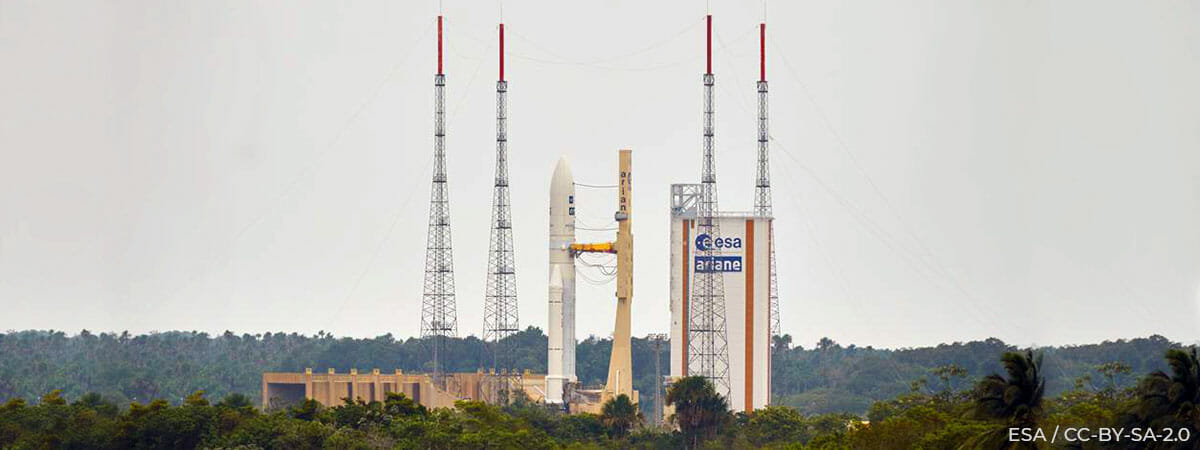We have all seen the famous takeoffs of the Apollo spacecraft from Cape Canaveral on television and, surely, we have dreamt of being in the control room and listening to the countdown live, with those harrowing T-minus 5 minutes before launch.
Global geopolitics have fueled activities at the launch facility in French Guiana, where ESA schedules many space missions of undeniable scientific interest.
But perhaps the launch events from French Guiana, which is also typically the spaceport for ESA missions that often include the participation of European countries, are not so well known. In fact, if we could jump on a flight to cover the distance of 6379 km (a little more than the average radius of the Earth!) that separates Europe from the launch point in South America, we will be able to witness in person the next big milestone in astronautics right there from mission control. We would simply have to ‘book our seats’ in this link.
So what are the next planned launch events? The answer is many and very diverse; but those managed by ESA and that have some scientific or technological interest are the following:
- Biomass (Earth observation) Q3 2023
- EarthCARE (Earth observation) Q1 2024
- Euclid (Scientific) Q1 2023
- ExoMars RSP (Planetary science) 2028
- Flex (Earth observation) Q2 2025
- Juice (Planetary science) Q2 2023
- Plato (Scientific) 2026
- Sentinels / Copernicus (Earth observation) 2028
- Arial (Scientific) 2029
Of those with a closer time horizon, let’s zoom in on the Euclid and Juice missions. Let’s take a look at some of their characteristics and the path they will follow to eventually enter the launch window or, conversely, be delayed for various reasons (as it happened recently with ExoMars and other missions due to the war in Ukraine and the impossibility of using the Soyuz platforms).
On January 24, 2013, NASA and ESA signed a cooperation agreement for their participation in the Euclid mission. The purpose was clear: to build a telescope to observe the energy and dark matter that populate deep space, and to better understand the expansion of the universe and its acceleration. To do this, they will use several visible and near-infrared cameras of several million pixels, in such a way that the combined images could provide measurements of the phenomenon known as “redshift” that are up to 10 times more accurate than their predecessors. The measurement of this deviation in the invisible spectrum due to the phenomenon of the Doppler effect of light, gives a measure of the speed of expansion of the universe, and with it, it is possible to infer the amount of energy and dark matter that prevents speed from being greater or less.
Some additional information about this spectacular telescope:
- The solar panels will be equipped with a stabilizing system that will allow them to steer themselves and aim with a precision of milliarcseconds, that is, 0.001 arcseconds, or less than 5 nanoradians.
- The visible spectrum will be covered by a 6 x 6 array of cameras, with a sensitivity of 600 million pixels.
- The near infrared spectrum will be equipped with 4 x 4 cameras in the spectrum from 1000 to 2000 nanometers, with a combined power of 65 million pixels.
- The telecommunications system will be capable of transmitting to earth 850 gigabits per day. It will use the Ka microwave band at a rate of 55 megabits per second during the 4 hours that its 35-meter high-gain antenna will be visible from the Cebreros base in Spain.
- The data storage capacity on board will be 300 GB, in order to accumulate the data in the event of the occasional impossibility of transmission to Earth.
On the other hand there’s the Juice mission, which aims to explore Jupiter’s icy moons and study the possibility of them containing solid water on their surfaces as well the composition of their atmosphere. It will also analyze the magnetic field generated by its host, the planet with the largest volume in our solar system, which to a certain extent is similar to that of Earth, unveiling other possible theories about how it is generated and the make-up of its inner core.
The space trick shot proposed for Juice, if launched in April 2023 as planned, will make it pass through the asteroid belt between Mars and Jupiter twice, as well as undergo several gravitational slingshots or gravity assists (flybys) between Earth and other celestial bodies (the Moon, Venus, and Mars). Its last return to Earth is expected to occur in 2029, reaching its destination in July 2031. At that time, it will enter a circular orbit to study the Galileo moon system (Ganymede, Calisto, and Europa; the moon Io is excluded from the mission since it is a Vulcan system and not icy). At the end of its life, the probe will begin a tilt manoeuvre to study the magnetic poles of the large gas planet. In fact, you can see the manoeuvre in animated form at this link.
Instruments on board this exploration satellite are many and very diverse: JANUS, MAJIS, UVS, SWI, GALA, RIME, J-MAG, PEP, RPWI, 3GM and PRIDE. The first three are vision systems (cameras) at different wavelengths to study the surfaces of each satellite and the planet, while the others are specific instruments for specific measurements: spectrometers, radars, and laser altimeters used to study the atmosphere, gravity, interaction with radio waves, and ice depth, as well as various ultrasensitive magnetometers to accurately map the Jovian magnetic field and how it affects its satellites.
Precisely, this last instrument is the one that has caused the most problems when it comes to designing, developing, and testing it on earth since it is mounted on a 10.5-meter-long pole so that interaction of the satellite’s own electronics does not disturb the ultra-sensitivity of the magnetometer at the tip.
Testing and fine-tuning of this instrument, carried out by SENER in Spain, has required the use of helium balloons to “neutralize” the force of terrestrial gravity that will be absent during deployment in Jupiter’s orbit, as well as a clean room that could house the entire body of the instrument without compromising the experiment.
Once JUICE finishes the final phase of its qualification, it will find itself aboard a ship headed for French Guiana. We wish JUICE and all of its siblings the best of luck and hope (really hope!) that the journey comes to fruition so that we can continue the space conquest and reveal the many secrets that still await us. And if, in addition, we can attend the launch, even better!



